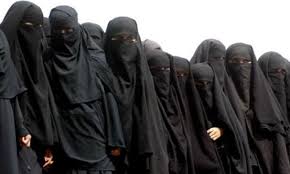by Paul Cliteur and Machteld Zee, ME FORUM
 Five years after France’s ban on wearing the niqab face veil and body-covering burqa in public went into effect, the twin threats of Islamist terrorism and mass migration looming over Europe have led to mounting public pressure for similar bans across the continent.
Five years after France’s ban on wearing the niqab face veil and body-covering burqa in public went into effect, the twin threats of Islamist terrorism and mass migration looming over Europe have led to mounting public pressure for similar bans across the continent.
Last year, the Netherlands banned face veils in government buildings, public transport, schools, and hospitals. In Spain, Italy, and Switzerland, numerous municipalities have imposed bans locally. Calls for bans have grown louder in Germany. In January, British Prime Minister David Cameron advocated proper and sensible rules prohibiting face veils in courts, schools, and other government buildings.
All of these initiatives have faced vigorous opposition from those who claim burqa bans violate freedom of religious expression and encourage anti-Muslim stereotyping. One of the reasons they have moved forward is a July 2014 European Court of Human Rights (ECtHR) ruling upholding the French ban. The ECtHR is a supranational European court that interprets the European Convention of Human Rights (ECHR), a binding treaty with human rights provisions that are largely copied from the Universal Declaration of Human Rights.
In interpreting the ECHR, the court often uses the doctrine of the “margin of appreciation,” which means in effect giving great latitude to the state in reconciling conflicting considerations of public interest, particularly in judgments concerning the limitation clauses in Article 8-11 ECHR (family life, freedom of religion, freedom of expression, and the freedom of association).
In the case at hand, the ECtHR validated the French government’s claim that the face plays a “significant role in social interaction” and that “the systematic concealment of the face in public places … falls short of the minimum requirement of civility that is necessary for social interaction.” Only two dissenting judges affirmed the right to be an outsider.
On the other hand, the ruling dismissed other, equally significant, rationales for the ban. Most notably, it rejected claims that the ban is necessary for gender equality, pointing out that face veiling is defended by the women who practice it. It also brushed aside respect for human dignity and public security as justifications for a blanket public ban.
Moreover, the ruling did not resoundingly dismiss claims that burqa bans reinforce anti-Muslim stereotypes. The court said it was “very concerned by the indications of some of the third-party interveners to the effect that certain anti-Islam remarks marked the debate.” Additionally, it acknowledged that “the debates surrounding the drafting of the bill may have upset part of the Muslim community.”
In this passage, the court implicitly recognized first that “Islamophobia” is a phenomenon deserving recognition by Europe’s highest court, and second that fierce public debate can be so upsetting to one bloc of people—which the court has lumped together based on their cultural heritage—that the free expression of others is somehow regrettable. Given the common use of the term “Islamophobia” to silence and defame legitimate expressions of concern about Muslim practices and beliefs, such hedging further diluted the impact of the ruling.
While new burqa bans in Europe aren’t likely to be overturned by the ECtHR anytime soon, the court’s narrow basis for upholding the French law and acknowledgement of “Islamophobia” were not the resounding vindication proponents of the ban were hoping for. The fight for a burqa-free Europe will continue to be hotly contested.
Paul Cliteur is a professor of jurisprudence at the University of Leiden. Machteld Zee is a political scientist and legal scholar. They wrote on this topic recently for Middle East Quarterly, a publication of the Middle East Forum.



Don’t get me wrong…there are some lovely Islamic gals. But as long as the vast majority of them look just like Yasser Arafat, I will continue to be enthusiastically pro-burka.
https://www.youtube.com/watch?v=Y-szC7XBPLA
Gosh, Trump right again, no need to vet the muslim immigrants.
It was never and it is not about Islamophobia but Islamofear!
But why is Belgium so antisemitic?